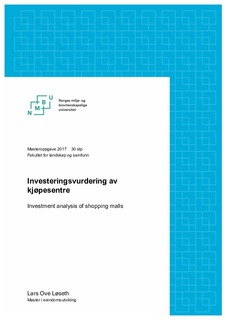| dc.contributor.advisor | Eika, Anders | |
| dc.contributor.author | Løseth, Lars Ove | |
| dc.coverage.spatial | Norway | nb_NO |
| dc.date.accessioned | 2017-09-21T12:05:02Z | |
| dc.date.available | 2017-09-21T12:05:02Z | |
| dc.date.issued | 2017 | |
| dc.identifier.uri | http://hdl.handle.net/11250/2456033 | |
| dc.description.abstract | Kjøpesentre har over en lengre periode vært et svært attraktivt investeringsobjekt i Norge. Noe som har ført til at landet globalt ligger på bronseplass når det kommer til antall kvadratmeter kjøpesenterareal per capita.
Denne oppgaven tar for seg hvordan investering i kjøpesentre bør vurderes ved å analysere de alternative modellene som kan benyttes i vurderingen samt hvordan markedet og selve kjøpesentereiendommen bør vurderes for å lage gode estimater til modellene.
Oppgaven tar en grundig gjennomgang av teori og tidligere arbeid innen temaet og utfører deretter dybdeintervjuer med personer som har vurdering av kjøpesenterinvesteringer som sitt spesialfelt.
Resultatene viser at det er en del forskjeller mellom aktørene i markedet når det kommer til fremgangsmåte for investeringsvurderinger, spesielt innen hvordan estimatene lages og hvordan avkastningskravet settes.
Konklusjonen er at det må gjennomføres grundige analyser av senterets markedsområde og deretter velge modell for vurdering ut i fra disse. DCF-modellen anbefales for stabile eller forutsigbare markeder, mens Nettokapitaliseringsmodellen bør benyttes når risikoen er stor for markedsendringer hvor effekten vanskelig lar seg estimere.
Videre må en analysen av markedsområdet sammen med en analyse av selve senteret brukes til å beregne potensialet for det aktuelle kjøpesentret. | nb_NO |
| dc.description.abstract | Shopping malls have been very attractive investments for a long time in Norway. This has seen the country claim global third place in terms of square meter of mall per capita.
This thesis investigates how investing in shopping malls should be considered by analyzing the different models that can be used in the assessment, and also how the market and the shopping mall property should be assessed to provide the correct estimates for the models.
The thesis will thoroughly review theory and past works from the field, before carrying out in-depth interviews of persons with specialty in the field of assessing shopping mall
investments.
The results show some differences between the actors in the market with regards to investment assessment methods, particularly how the estimates are made and how to set the required rate of return.
The conclusion is that thorough analyses of the mall’s market area must be carried out before choosing assessment model based on these. The DCF model is recommended for stable and predictable markets, while the Cap Rate model should be used when the risk is high for market changes in which the effects are difficult to estimate.
Furthermore, an analysis of the market area combined with an analysis of the actual mall must be utilized to estimate the potential of the shopping mall in question. | nb_NO |
| dc.language.iso | nob | nb_NO |
| dc.publisher | Norwegian University of Life Sciences, Ås | nb_NO |
| dc.rights | Attribution-NonCommercial-NoDerivatives 4.0 Internasjonal | * |
| dc.rights.uri | http://creativecommons.org/licenses/by-nc-nd/4.0/deed.no | * |
| dc.subject | Investeringsvurdering | nb_NO |
| dc.subject | Kjøpesentre | nb_NO |
| dc.subject | Verdivurdering | nb_NO |
| dc.subject | Eiendom | nb_NO |
| dc.subject | Eiendomsutvikling | nb_NO |
| dc.subject | Handelseiendom | nb_NO |
| dc.title | Investeringsvurdering av kjøpesentre | nb_NO |
| dc.title.alternative | Investment analysis of shopping malls | nb_NO |
| dc.type | Master thesis | nb_NO |
| dc.description.version | submittedVersion | nb_NO |
| dc.subject.nsi | VDP::Matematikk og Naturvitenskap: 400::Matematikk: 410::Analyse: 411 | nb_NO |
| dc.subject.nsi | VDP::Samfunnsvitenskap: 200::Økonomi: 210::Bedriftsøkonomi: 213 | nb_NO |
| dc.source.pagenumber | 142 | nb_NO |
| dc.description.localcode | M-EUTV | nb_NO |

